#Dock Leveller Singapore
Text
#Air-Powered Dock Leveler Industry Analysis 2023#Air-Powered Dock Leveler Industry Analysis 2022#Air-Powered Dock Leveler Market 2023#Air-Powered Dock Leveler Market Analysis#Air-Powered Dock Leveler Market Data#Air-Powered Dock Leveler Market Demand 2023#Air-Powered Dock Leveler market forecast 2023#Air-Powered Dock Leveler Market Growth#Air-Powered Dock Leveler Market In Apac#Air-Powered Dock Leveler Market in Europe#Air-Powered Dock Leveler market in US 2023#Air-Powered Dock Leveler Market Outlook 2023#Air-Powered Dock Leveler Market players#Air-Powered Dock Leveler Market in United States#Air-Powered Dock Leveler Market in Spain#Air-Powered Dock Leveler Market in Germany#Air-Powered Dock Leveler Market in Saudi Arabia#Air-Powered Dock Leveler Market Singapore#Air-Powered Dock Leveler Market in Australia#Air-Powered Dock Leveler Market in United Kingdom
0 notes
Text
Lewis Hamilton could be crowned world champion for last season if Red Bull are found guilty
F1 bombshell! Lewis Hamilton could be crowned world champion for last season if Red Bull are found guilty of breaking the sport’s £114m spending cap during Max Verstappen’s controversial 2021 title-winning year
F1 chiefs are investigating Red Bull's spending cap for the 2021 season
Lewis Hamilton could be awarded the championship title if they are found guilty
Hamilton was controversially beaten to the title by Max Verstappen last season
Mercedes boss Toto Wolff has called on the FIA to enforce their rules
By Jonathan McEvoy for the Daily Mail
Published: 17:56 EDT, 30 September 2022 | Updated: 17:56 EDT, 30 September 2022
Formula One’s rulers are under pressure to crown Lewis Hamilton world champion if Red Bull are found guilty of breaking the spending cap during Max Verstappen’s controversial 2021 title-winning year.
In a twist that reopens the most contentious decider in the sport’s history, reports have surfaced in Italy and Germany claiming to show Red Bull exceeded last year’s £114million limit.
Team principal Christian Horner denied the accusations yesterday, but Mercedes counterpart Toto Wolff called on the FIA to enforce their rules, which permit teams and drivers to be docked points.
Max Verstappen could face the prospect of losing his 2021 F1 championship title
Toto Wolff has demanded the FIA enforce their own rules on Red Bull's spending cap
With Verstappen triumphing on the last lap of the final race in Abu Dhabi to pip Hamilton (below) by eight points, the FIA’s adjudication could not be more sensitive.
Speaking ahead of tomorrow’s Singapore Grand Prix, Wolff said: ‘The cost cap is probably the most important evolution of regulations to keep a level playing field.
'It is of huge importance that these regulations are policed. The FIA, and particularly Mohammed (ben Sulayem, their president), have shown a pretty robust stance on enforcing all kinds of regulations.
Lewis Hamilton (front) was controversially pipped to the title last season by Verstappen
So if we are talking now about something big, he will show the same integrity and leadership that he has before.’
The FIA are due to release their findings on Wednesday.
Red Bull chief Christian Horner has denied the spending cap accusations aimed at his team
Advertisement
Share or comment on this article:
Lewis Hamilton could be crowned world champion for last season if Red Bull are found guilty
via Formula One | Mail Online https://www.dailymail.co.uk?ns_mchannel=rss&ns_campaign=1490&ito=1490
#F1#Lewis Hamilton could be crowned world champion for last season if Red Bull are found guilty#Formula 1
3 notes
·
View notes
Text
Internet of Things (IoT) in Logistics Market to Witness Excellent Revenue Growth Owing to Rapid Increase in Demand
Latest released the research study on Global Internet of Things (IoT) in Logistics Market, offers a detailed overview of the factors influencing the global business scope. Internet of Things (IoT) in Logistics Market research report shows the latest market insights, current situation analysis with upcoming trends and breakdown of the products and services. The report provides key statistics on the market status, size, share, growth factors of the Internet of Things (IoT) in Logistics The study covers emerging player’s data, including: competitive landscape, sales, revenue and global market share of top manufacturers are Cisco Systems Inc. (United States), Oracle Corporation (United States), Octonion SA (Switzerland), Kaa IoT Technologies, LLC. (United States), Amazon Web Services (United States), International Business Machine (IBM) Corporation, NEC Corporation (Japan), Honeywell International (United States), SAP SE (Germany), Intel Corporation (United States), Bosch Software Innovations GmbH (Germany)
Free Sample Report + All Related Graphs & Charts @: https://www.advancemarketanalytics.com/sample-report/65408-global-internet-of-things-iot-in-logistics-market?utm_source=Organic&utm_medium=Vinay
Internet of Things (IoT) in Logistics Market Definition:
The global Internet of Things (IoT) in the Logistics market is expected to witness high demand due to technological advancements that help logistics industry sees a rapid transformation and growth. Internet of Things (IoT) in Logistics is the term which uses for a complete digital, flexible and connected supply chain optimized for e-commerce and last-mile and last-minute delivery. There are various applications of the Internet of Things (IoT) in Logistics such as location management system, inventory tracking and warehousing, predictive analysis, IoT and blockchain for supply chain management, self-driving vehicles and drone-based delivery. With the deployment of innovative technology, digitalization has witnessed enlarged implementation across the transportation and logistics industry.
Market Trend:
Adoption of Social Media Platforms
Rising Growth in E-Commerce
Market Drivers:
Fueling Use of Internet
Increasing Awareness of IoT solutions
Market Opportunities:
Technological Advancement such as Drone Based Delivery in Internet of Things in Logistics
Rising Opportunities in Emerging Country
The Global Internet of Things (IoT) in Logistics Market segments and Market Data Break Down are illuminated below:
by Application (Fleet, Warehouse, Freight, Yard/ Dock), Software (Traffic and Fleet Management, Resource and Energy Monitoring, Safety and Security), Hardware (RFID Tags, Beacon, Screen/Display), Functions (Location Management Systems, Inventory Tracking and Warehousing, IoT Technology and Predictive Analytics, IoT and Blockchain for Supply Chain Management, Self-Driving Vehicles, Drone-Based Delivery), Organisation Size (Small-Mid-Sized Organizations, Large Sized Organizations)
Region Included are: North America, Europe, Asia Pacific, Oceania, South America, Middle East & Africa
Country Level Break-Up: United States, Canada, Mexico, Brazil, Argentina, Colombia, Chile, South Africa, Nigeria, Tunisia, Morocco, Germany, United Kingdom (UK), the Netherlands, Spain, Italy, Belgium, Austria, Turkey, Russia, France, Poland, Israel, United Arab Emirates, Qatar, Saudi Arabia, China, Japan, Taiwan, South Korea, Singapore, India, Australia and New Zealand etc.
Enquire for customization in Report @: https://www.advancemarketanalytics.com/enquiry-before-buy/65408-global-internet-of-things-iot-in-logistics-market?utm_source=Organic&utm_medium=Vinay
Strategic Points Covered in Table of Content of Global Internet of Things (IoT) in Logistics Market:
Chapter 1: Introduction, market driving force product Objective of Study and Research Scope the Internet of Things (IoT) in Logistics market
Chapter 2: Exclusive Summary – the basic information of the Internet of Things (IoT) in Logistics Market.
Chapter 3: Displayingthe Market Dynamics- Drivers, Trends and Challenges of the Internet of Things (IoT) in Logistics
Chapter 4: Presenting the Internet of Things (IoT) in Logistics Market Factor Analysis Porters Five Forces, Supply/Value Chain, PESTEL analysis, Market Entropy, Patent/Trademark Analysis.
Chapter 5: Displaying market size by Type, End User and Region 2015-2020
Chapter 6: Evaluating the leading manufacturers of the Internet of Things (IoT) in Logistics market which consists of its Competitive Landscape, Peer Group Analysis, BCG Matrix & Company Profile
Chapter 7: To evaluate the market by segments, by countries and by manufacturers with revenue share and sales by key countries (2021-2026).
Chapter 8 & 9: Displaying the Appendix, Methodology and Data Source
Finally, Internet of Things (IoT) in Logistics Market is a valuable source of guidance for individuals and companies in decision framework.
Data Sources & Methodology
The primary sources involves the industry experts from the Global Internet of Things (IoT) in Logistics Market including the management organizations, processing organizations, analytics service providers of the industry’s value chain. All primary sources were interviewed to gather and authenticate qualitative & quantitative information and determine the future prospects.
In the extensive primary research process undertaken for this study, the primary sources – Postal Surveys, telephone, Online & Face-to-Face Survey were considered to obtain and verify both qualitative and quantitative aspects of this research study. When it comes to secondary sources Company's Annual reports, press Releases, Websites, Investor Presentation, Conference Call transcripts, Webinar, Journals, Regulators, National Customs and Industry Associations were given primary weight-age.
For Early Buyers | Get Up to 20% Discount on This Premium Report: https://www.advancemarketanalytics.com/request-discount/65408-global-internet-of-things-iot-in-logistics-market?utm_source=Organic&utm_medium=Vinay
What benefits does AMA research study is going to provide?
Latest industry influencing trends and development scenario
Open up New Markets
To Seize powerful market opportunities
Key decision in planning and to further expand market share
Identify Key Business Segments, Market proposition & Gap Analysis
Assisting in allocating marketing investments
Definitively, this report will give you an unmistakable perspective on every single reality of the market without a need to allude to some other research report or an information source. Our report will give all of you the realities about the past, present, and eventual fate of the concerned Market.
Thanks for reading this article; you can also get individual chapter wise section or region wise report version like North America, Europe or Southeast Asia.
Contact Us:
Craig Francis (PR & Marketing Manager)
AMA Research & Media LLP
Unit No. 429, Parsonage Road Edison, NJ
New Jersey USA – 08837
1 note
·
View note
Text
Essential Insights on Wire Rope Hoists, Jib Cranes, Overhead Cranes, and Gantry Cranes in Singapore
Introduction:
In Singapore’s bustling industrial landscape, various lifting and material-handling equipment play a crucial role in optimizing efficiency and safety. Among these, wire rope hoists, jib cranes, overhead cranes, and gantry cranes have emerged as indispensable solutions.
This article delves into the functionalities and applications of these lifting systems, highlighting their significance in Singapore’s industrial sectors.
Wire Rope Hoists:
Wire rope hoists are robust lifting devices designed to transport heavy loads vertically. They employ high-tensile wire ropes wound around a drum, powered by an electric motor.
Wire rope hoists are known for their strength, durability, and versatility, making them ideal for various industrial applications, including construction, manufacturing, and warehousing.
2. Jib Cranes:
Jib cranes are versatile lifting mechanisms characterized by a horizontal boom, known as a jib, which supports a movable hoist. They are commonly used in workshops, docks, and warehouses to handle loads in a limited working area. Jib cranes offer 180-degree or 360-degree rotation, providing flexible and precise lifting and positioning capabilities.

These cranes consist of a bridge beam that traverses horizontally along elevated runways, with a hoist and trolley system for vertical and horizontal movements. Overhead cranes offer exceptional load capacities and can cover large areas, making them suitable for handling bulky and heavy objects.
4. Gantry Cranes:
Gantry cranes are similar to overhead cranes but operate on a different structure. Instead of runways, gantry cranes have supporting legs or columns that allow them to move on ground-level rails or wheels.
Gantry cranes excel in outdoor settings, such as shipyards, construction sites, and container terminals, where the need for mobility and flexibility is paramount.
Significance in Singapore’s Industrial Landscape:
The industrial sectors in Singapore greatly benefit from these lifting systems, playing a vital role in enhancing productivity, efficiency, and safety.
Wire rope hoists facilitate vertical material transportation in factories, construction sites, and logistics centers. Jib cranes offer optimal maneuverability, enabling precise and quick loading and unloading of goods.
Overhead cranes provide heavy-lifting capabilities for tasks involving large machinery or containers. Gantry cranes deliver the versatility required in outdoor environments, facilitating the efficient handling of cargo and materials.
Conclusion:
Wire rope hoists, jib cranes, overhead cranes, and gantry cranes are essential components of Singapore’s industrial infrastructure. Their diverse applications and functionalities cater to the unique lifting needs of different sectors.
By utilizing these advanced lifting systems, businesses in Singapore can enhance productivity, streamline operations, and ensure the safety of workers.
As technology continues to evolve, these lifting solutions will continue to play a pivotal role in Singapore’s industrial growth, contributing to a more efficient and prosperous economy.
0 notes
Text
December 7 2021 Barcelona

It would be remiss of me to not mention that today is the 80th anniversary of the bombing of Pearl Harbor. Pearl Harbor Remembrance Day is an opportunity for everyone to reflect on the horrors and destruction of war and pray for peace and reconciliation everywhere, as well as to honor those whose lives were lost on that infamous day.



According to Wikipedia:
“The attack on Pearl Harbor was a surprise military strike by the Imperial Japanese Navy Air Service upon the United States against the naval base at Pearl Harbor in Honolulu, Territory of Hawaii, just before 8:00 a.m. (local time) on Sunday, December 7, 1941. The United States was a neutral country at the time; the attack led to its formal entry into World War II the next day. The Japanese military leadership referred to the attack as the Hawaii Operation and Operation AI and as Operation Z during its planning.
Japan intended the attack as a preventive action. Its aim was to prevent the United States Pacific Fleet from interfering with its planned military actions in Southeast Asia against overseas territories of the United Kingdom, the Netherlands, and those of the United States. Over the course of seven hours there were coordinated Japanese attacks on the US-held Philippines, Guam, and Wake Island and on the British Empire in Malaya, Singapore, and Hong Kong.
The attack commenced at 7:48 a.m. Hawaiian Time (6:18 p.m. GMT). The base was attacked by 353 Imperial Japanese aircraft (including fighters, level and dive bombers, and torpedo bombers) in two waves, launched from six aircraft carriers. Of the eight US Navy battleships present, all were damaged, with four sunk. All but USS Arizona were later raised, and six were returned to service and went on to fight in the war. The Japanese also sank or damaged three cruisers, three destroyers, an anti-aircraft training ship, and one minelayer. More than 180 US aircraft were destroyed and 2,403 Americans were killed, while another 1,178 others were wounded. Important base installations such as the power station, dry dock, shipyard, maintenance, and fuel and torpedo storage facilities, as well as the submarine piers and headquarters building (also home of the intelligence section) were not attacked. Japanese losses were light: 29 aircraft and five midget submarines lost, and 64 servicemen killed. Kazuo Sakamaki, the commanding officer of one of the submarines, was captured.
Japan announced declarations of war on the United States and the British Empire later that day (December 8 in Tokyo), but the declarations were not delivered until the following day. The British government declared war on Japan immediately after learning that their territory had also been attacked, while the following day (December 8) the United States Congress declared war on Japan. On December 11, though they had no formal obligation to do so under the Tripartite Pact with Japan, Germany and Italy each declared war on the US, which responded with a declaration of war against Germany and Italy. There were numerous historical precedents for the unannounced military action by Japan, but the lack of any formal warning (required by part III of the Hague Convention of 1907), particularly while peace negotiations were still apparently ongoing, led President Franklin D. Roosevelt to proclaim December 7, 1941, "a date which will live in infamy". Because the attack happened without a declaration of war and without explicit warning, the attack on Pearl Harbor was later judged in the Tokyo Trials to be a war crime.”

Claire’s kitty, Beuni, whom I call Bebeuni, really liked the toys I brought to him when we had our French class at Clair’s apartment today. He isn’t a kitten anymore! He is growing into a CAT! He still likes to play, though and he’s very friendly. Being with him makes me want KITTENS! Maybe our cat, Matilda, would be happier with some company and feel less lonely if I brought her some sisters?
0 notes
Text
Grand Banks to Sturgeon Bay, WI. (Part 1)
Nancy and I delivered a 42’ Grand Banks trawler from Columbus MS, to Sturgeon Bay WI, Sept-Oct. 2022. The trip took 25 days and approximately 928 miles, with 20 locks. We put 175 hours on the two engines.
On Sept. 26, 2022 we flew from Syracuse NY to Columbus MS. Where we boarded the “Susan Lee” (SL). It is a 1974 boat built in Singapore. This boat was kept in meticulous shape, mostly in freshwater.
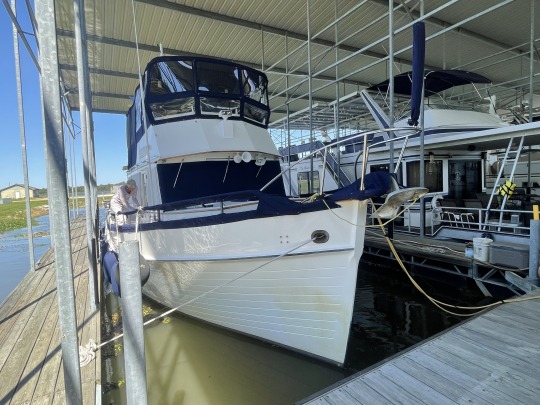
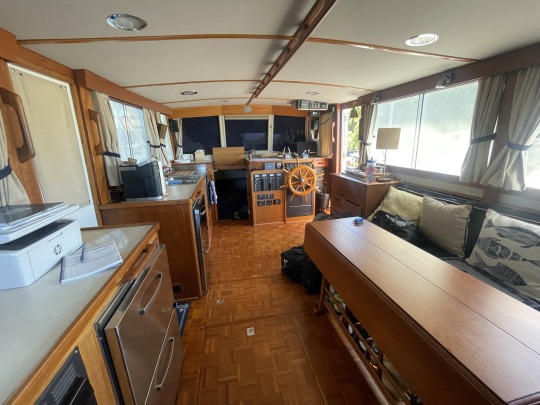

After a quick check of the boat we borrowed the marina’s courtesy car and made a run for groceries. This is where Nancy’s help is so valuable. She bought $400 of food from Walmart, providing us with 2 weeks of balanced meals.

We started out early the next morning at mile marker (mm) 335 on the Tennessee-TomBigBee river. I had stayed at the same marina in June on another trip. Our first lock was the “Aberdeen Lock” at mm 357. Aberdeen lock is pretty typical of the US Army Corp of Engineer (USACE) locks. It is 600 ft. long and 100 ft. wide. This lock has a lift of 30 ft.
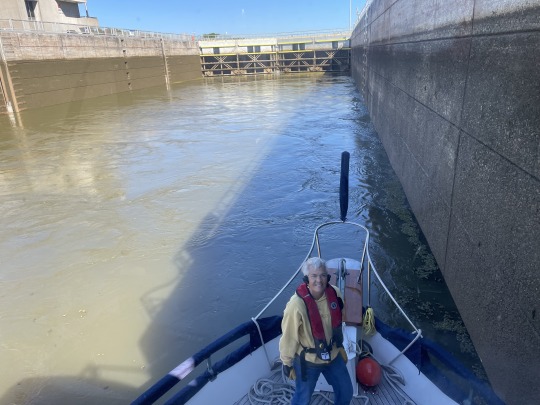
Here is Nancy on the foredeck wearing a required life Jacket while in the lock. Plus she has heavy gloves. This trawler had everything including a set of wireless headsets, referred to as “marriage savers” on boats. We were able to just talk to each other without screaming. Nancy gives me distance to the lock wall or dock. Since I can not see them very well from the upper helm.
She has already tied us “starboard side to”, on a floating bollard. More about that later. This trawler has both bow and stern thrusters, plus two engines giving me differential thrust. The down side of the Grand Banks is, it has very small rudders. At slow speed you end up spinning the wheel like the “Wheel of Fortune”. When using differential thrust you just park the rudder in the center and maneuver the boat by going either one in forward and the other in reverse. Or some other variation. Below is a photo taken of a similar Grand Banks running gear.


This is the first nights dinner of pork chops, field peas and mashed potatoes. We had anchored well off of the channel at mm 393, just north of Fulton MS. Each day when we retrieve the anchor, Nancy has to hose off the mud stuck in the chain links. This keeps the anchor locker clean.

We woke up to steam rising from the river. Mornings were calm with winds picking up in the afternoon. Rankin Lock was just up the river with a 31 ft. lift. Below is Nancy tied off to a “floating bollard”. It raises and lowers as the water level in the lock changes. Beware it could hang up. Two schools of thought. Either do not cleat the line, just wrap it around the cleat keeping tension on it. Or be ready with a sharp knife to cut the line.
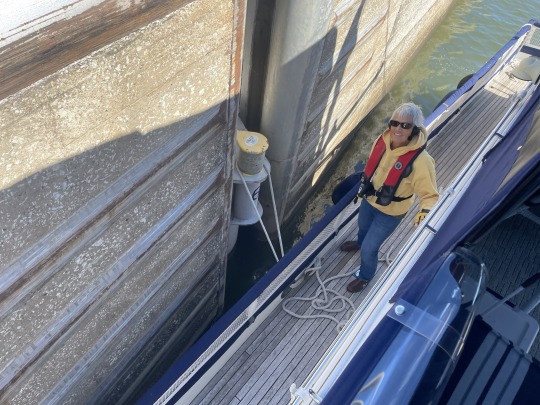
After Rankin lock came Montgomery lock with a 33’ lift. Then the Jamie Whitten Lock with a 84 ft. lift. That morning our generator would not start or even turn over. It appeared to be electrical in nature. After consulting with my boss, Karl. It was decided that we would pull in at Aqua Yacht Harbor Marina, just south of the Tennessee border. We pulled in around 3 pm. A lead mechanic came and did a quick look at the generator and agreed it was electrical in nature. He would send a mechanic around 9:30 the next morning. The next day the two of them showed up. The other mechanic pushed in a circuit breaker that was painted red like the whole generator. It started right up. I had gone through the manual and it mentioned a circuit breaker, but never had a diagram to show it. That was a $100 lesson.
While we were docked there, I was talking to a guy who was working on his boat across from us. His voice sounded familiar. I finally asked if he ever worked in Charlotte NC, 30 years ago. Turns out he was in a new hire class at Piedmont Airlines right behind me in 1987. Barry Marshall is still flying for American. He lives an hour and a half away, in Memphis. Small world.
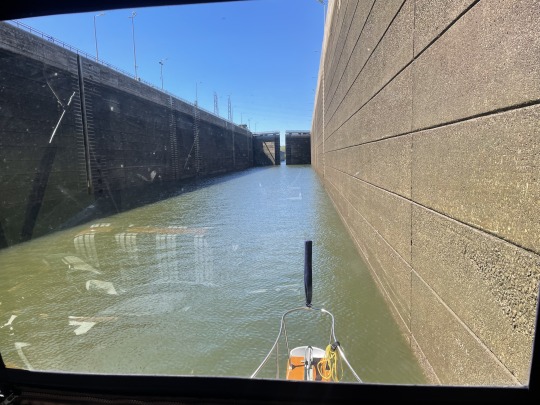
This is the 84 ft. lift Jamie Whitten lock. It is the highest lift we will go through. A bit scary thinking about how much force is on the other side of the forward door. Water constantly leaks around the door. At the top of the lift, I glanced at the depth sounder and saw 110 ft. while still in the lock. Amazing!

Here, Nancy is concentrating on steering SL, while slowly passing this “Tow boat” pushing multiple barges. We only made about 8.5 kts. while on the rivers. Which only gives us a couple of knots advantage over the “tow boats” going the same direction. Nancy had called the Captain of this “Tow boat”, who told her to pass on “two whistles”. It would take us up to 12 minutes to pass one of these large barges. They can be 3 barges wide and 5 barges long.
Just because you passed the barge, doesn’t mean you are out of danger. If you lose steering or engines while you are still a mile in front of these guys. They can not really turn or stop in time to keep from running you over.
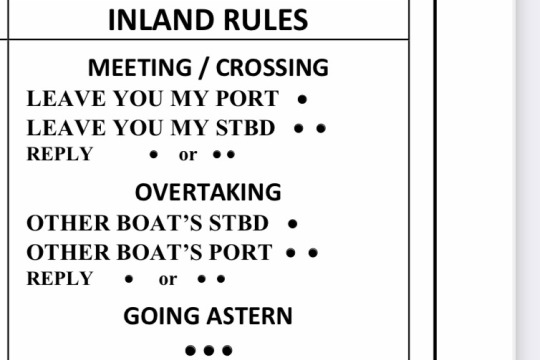
Above is the “cheat sheet” with the whistle signals. Each dot equals a whistle. We say on VHF that we will pass on “one/two whistles”. In the old days whistles were actually used. Now for the most part it is just a term used on the VHF radio.
While on the Ohio river just short of the Mississippi a tow boat Captain had been parked with the nose of his barge against the bank. He was pulling off the bank in reverse and told me to “pass on ONE whistle”. That was impossible. His barges were still on the bank, and I could not pass on his starboard side. I asked him, “ You sure, you do not want me to pass on TWO whistles?”. He quickly answered, “Yes, two whistles”. Thinking back, I believe the Captain was turned around looking astern and got mixed up.

Nancy is a clean freak and we all know that, here is the proof. Not only does she vacuum the floor but the ceiling also. Actually she was very cleaver in vacuuming bugs off of the ceiling instead of smashing them and making a mess.

The anchorage that night was at Eagle Nest cutoff, on the Tennessee River. Plenty wide, no barges, just a gentle current holding us in place. Nice not worrying about a tidal change and fouling an anchor in the middle of the night. We woke up before daybreak with lots of steam coming off of the river. Temperatures are in the low 40’s. Heavy dew on the isenglass prevents us from seeing very well for the first hour or so. We open the front window on the upper helm till it clears off. So it is a bit chilly first thing in the morning.
As we motored up the river with the steam rising. I witnessed a very strange thing. We have all seen “dust devils”. This was a “Steam Devil”. It rose at least 40-50 feet in to the air, slowly dancing around.

Another great breakfast of sausage and eggs to start the day.

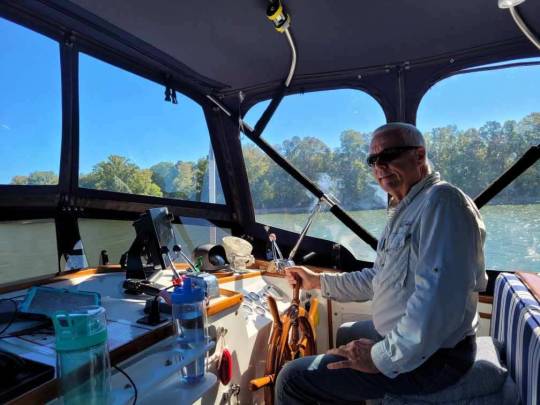
Photo of the upper helm, with its “wheel of fortune” steering wheel.
The next night we anchored off of the side of Kentucky Lake at Little Crooked Creek after an 83 mile day. Having done my homework I picked a great spot.
When we pulled in, there was another boat anchored exactly where I wanted to go. So I had to find another spot with enough swing room. This is a manmade lake, which flooded roads, bridges, and cemeteries. Right behind us was a submerged bridge. Not something you want your anchor to get hung up on. See the second photo below. The photos are snap shots from Navionics which I use to navigate with.


Below is a photo taken while Nancy is hauling in the anchor chain and washing it down. Note the orange “Trip bouy” hanging off to the right. The theory is, should the anchor get hung up on something like a tree or submerged bridge. You motor up to it and pull the anchor out backwards. This would be very tough to do with high current in some of the rivers.

At the end of each day, I do my homework for the next days travel. Plus keeping a journal on my iPad of times and distance done for the day.
Each morning we check engine oil, transmission fluid, alternator belt and fuel filters. Engines have to be warmed up 15 minutes minimum. Once engine water temperature is approaching 200 degrees I start motoring for the day.
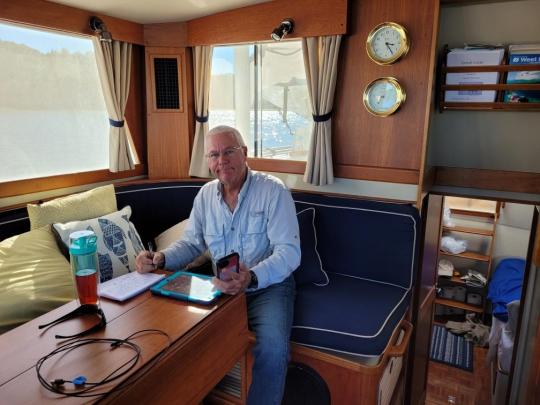
Here is an abandoned grain Dock after the area flooded. About a mile further is a car ferry that runs across the lake. We passed about a half dozen on our trip.

We had an issue with excessive water leak coming from the port prop shaft. I was able to pull into a quite cove and tighten the packing nut. The packing nut needs to “weep” while running, just not pour water into the boat like it was doing.
We ran up to Green Turtle Bay Marina for fuel and waste pump out. To do this, you have to take a canal cut between the Kentucky Lake to the Barkley Lake. They were full and could not allow us to dock for the night. Talking to the dockmaster about local knowledge. He said “Do not anchor” anywhere on the Barkley Lake. Taking his advice we ran back to Kentucky Lake and found a small cove.
This cove is very tight. One “day boat” was parked where I would have preferred. That left me to anchor very close to a submerged bridge. See the photo below.

The next day we had two options of locks and rivers to get to the Ohio River. Commercial barge traffic has priority over Recreational Craft (RC). The Kentucky lock and Tennessee river are 25 miles shorter than the Barkley lock and Cumberland River. Taking a chance I called the Kentucky Lock by cell phone. The lockmaster said, “Come on down, no barge traffic”. That saved us 25 miles. This was one of only two locks where we dropped down in height.


This is the Kentucky Lock with a drop of 57 feet. There is a thing called, “The Great American Loop”. Those doing the loop are known as “Loopers”. This time of year, all of the “Loopers” are migrating south. We are the only ones heading north. As many times that I tell lockmasters we are “up bound” they don’t catch on and have we have to wait while they turn the lock around for us.
Today we make 78 miles covering about 298 miles to date, going through 10 of the 20 locks on this trip.
Once we hit the Ohio River the barge traffic is very common. Just when you think it is obvious which side the Tow Captain will tell you to pass on. They tell you the other side. Sometimes they are going to an area to park the barge or cut across our bow.
That evening we anchored at the very junction of the Ohio and Mississippi River at the Angelo Tow head. Looking at Goggle Earth it looks like you can motor up the inside of the oxbow. Busy place, tow boats everywhere. Lots of current, dredge and bridge behind us. There was already one boat anchored close to shore. Water levels are down and there are snags sticking out above the surface. If levels had been higher, good chance I would have tried to anchor further up the canal. No telling what damage would have happened. Talked to the other couple and they had been up the canal in a dinghy. Agreed it was not navigable.

Now we are officially in the “Mighty Mississippi River”, I was dreading this 217 mile leg. The head current will drop our speed from 8.5 kts. to 6.5 kts. making passing a tow very long and tedious. You have limited width to pass between the shallows and the barge. They move so much water around between their prop wash and pressure wave, you are fighting the wheel the whole time. Last time I was here in June there were lots of floating tree parts. Some only a foot long, but one tree was 50 ft. long.
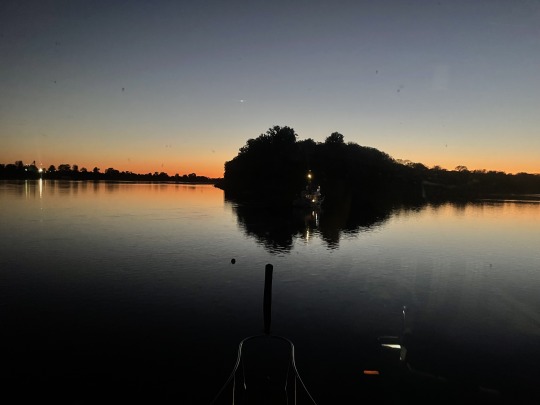
This is was taken at sunset of the boat anchored just ahead of us at Angelo Tow head.
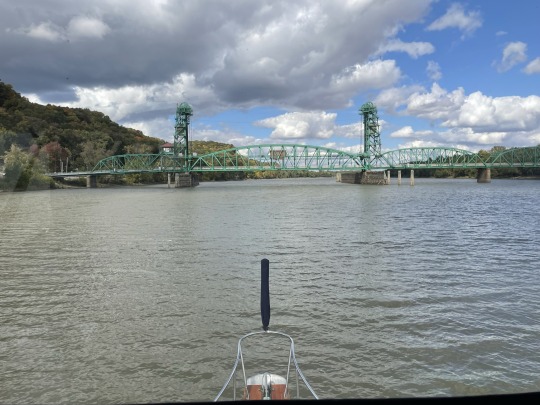
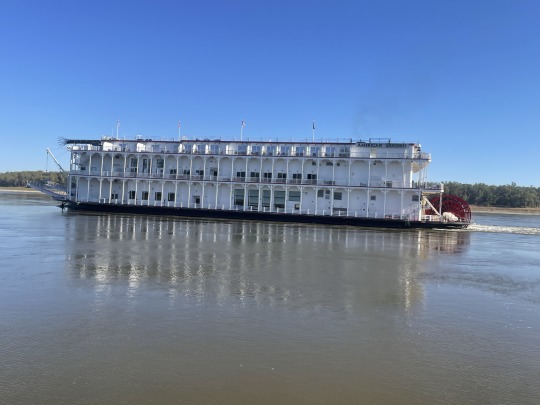
What is the Mississippi without a paddle wheeler? Here is the “American Princess” heading to Memphis.

When traveling the Mississippi there are almost no marinas and no tow services. Only two fuel stops in 200 miles. And only two safe anchorages off the actual river. So we had a short day of a 47 mile run to “Little Diversion Channel” just south of Cape Girardeau, MO. The channel is 8 ft. deep and navigable for about a half mile. We were the 4th boat in from the far end nearest the bridge. By nightfall there were 10 “Loopers” anchored with us.
One guy was super nervous, it was only his third day of boating. He picked a hell of a leg to learn on. At least he was buddy boating with two other boats. The channel was so narrow you could not put out enough anchor chain, without swinging on too the shore. So we put out a stern anchor, just laying it in the mud to keep us from swinging. The nervous boater said he was going to stay up all night on anchor watch. So when sent over a “care package” of beer and Little Debbie’s.
Next morning was foggy. We left at daybreak heading north to Kidd’s fuel dock at Cape Girardeau. I had called Charlie Brown the day before and arranged to borrow his fuel dock for two hours while he was in a meeting. The owner of the boat, Dr. Bernie Patterson, needed to get some jewelry off the boat for his girlfriend. We had him bring 2 cases of oil and absorbent pads. He spent an hour and a half showing us how to drop the radar mast so we could get under bridges near Chicago. This really cut into our day but it all worked out.
We ran till about 4pm and I checked out a possible anchorage off the side of the channel behind a wingdam. The river looked lower than I remembered. The depths didn’t check with my Navionics maps. Wisely I decided not to press into the anchorage. Instead I made a last ditch effort to run to Kaskaskia Lock. We were running out of daylight, with no good options to anchor.
Did we make it before dark?
Was there room to tie off to the lock wall, or was it full of “Loopers” already?
For the answers, see Part 2.
0 notes
Link
In the automotive field, Mhe-Demag is a trusted brand today for all types of commercial and industrial vehicle needs. We are providing intercontinental lifting leaders in Konecranes and working in this field for 50 years. We are especially known for material handling. Furthermore, we maintain a complete range of industrial cranes and hoists and warehousing equipment such as lift trucks and dock revellers. To get free quotes, visit the website.
#Crane Parts Suppliers in Singapore#Crane Parts manufacturer in Singapore#overhead cranes parts supplier#overhead cranes part supplier#explosion proof overhead crane#shipyard crane parts supplier singapore#Wheel Loader Singapore#Telehandler Singapore#scissor lift platform hire#Dock Leveller Singapore#Crane Spare Parts Singapore#stage lift in Singapore#AWP rental & suppliers singapore#mechanical car parking system manufacturers#Roller shutter suppliers#portal crane parts manufacturer singapore#Lightweight crane parts suppliers singapore
0 notes
Text

poem about education in singapore, cut out of math papers i did this year
Transcript:
The gradient function of excellence
is such that reflex intercepts displacement
A hot air balloon ascending to a fixed point
Let the cost of riding be distinct
floating without restrictions,
water levels in a dock satisfy
is that feasible ?
find the maximum value of
freshly baked bread, a Cadbury Ferris Wheel.
your horizon enclosed by parallel marks
a hollow cylinder of continuous work
Hence, or otherwise,
remain ill.
End of paper
#poetry#singlit#my writing#i wrote the very poor effort! title myself no real need to worry#bc. for real. the score i got after marking my own paper HA HA
69 notes
·
View notes
Link
Why Start a New Country?
We want to be able to peacefully start a new country for the same reason we want a bare plot of earth, a blank sheet of paper, an empty text buffer, a fresh startup, or a clean slate. Because we want to build something new without historical constraint.
The financial demand for a clean slate is clear. People buy millions of acres of vacant land and incorporate hundreds of thousands of new companies each year, spending billions just to get that fresh start. And now that it is possible to start not just new companies but new communities and even new currencies, we see people flocking to create those as well.
The societal value of a clean slate is also clear. In the technology sector alone, the ability to form new companies has created literally trillions of dollars in wealth over the past few decades. Indeed, if we imagine a world where you couldn't just obtain a blank sheet of paper but had to erase an older one, where you couldn't just acquire bare land but had to knock down a standing building, where you couldn't just create a new company but had to reform an existing firm, we imagine endless conflict over scarce resources.
…
There are at least six ways to start new countries that have been publicly discussed. Three are conventional and three are unconventional. We will introduce them only to deprioritize them all in favor of a seventh.
1. Election
The most conventional way to start a new country involves winning sufficient power in an election to either (a) rewrite the laws of an existing state or (b) carve out a new one from scratch with the consent of the international community. This is the most widely discussed path, and by far the most crowded. Many people care about this avenue, perhaps too many.
2. Revolution
The second obvious way is to carry off a political revolution. We don't advise attempting this. Particularly momentous elections are sometimes referred to as revolutions, though a revolution frequently involves bloodshed. Revolutions are infrequent, but everyone knows that they mean a new government.
3. War
The third conventional way is to win a war. We don't advise attempting this either! A war is of course not independent from the other two. Indeed, both elections and revolutions can lead to wars that end up carving out new polities. Like a revolution, a war is infrequent and undesirable, but again is widely known as a means by which national borders may be rewritten.
4. Micronations
Now we get to the unconventional. The most obvious of the unconventional approaches – and the one most people think of when they hear the concept of "starting a new country" – occurs when an eccentric plants a flag on an oil platform or disputed patch of dirt and declares themselves king of nothing. If the issue with elections is that too many people care about them, the issue with these so-called micronations is that too few people care. Because a state (like a currency) is an inherently social affair, a few people in the middle of nowhere won't be able to organize a military, enforce laws, or be recognized by other nations. Moreover, while an existing state may be content to let people harmlessly LARP a fake country in their backyard, an actual threat to sovereignty typically produces a response with real guns, whether that be the Falklands or Sakhalin.
5. Seasteading
Here we start to get interesting. Conceived by Patri Friedman and backed by Peter Thiel, seasteading essentially starts with the observation that cruise ships exist, and asks whether we could move from a few weeks on the water at a time to semi-permanent habitation on international waters (with frequent docking, of course). As the cost of cruise ships has fallen recently, this approach is becoming more feasible. But we haven't yet seen a working example.
6. Space
Perhaps the most prestigious of the start-a-new-country paths is the idea of colonizing other planets. Unlike seasteading or micronations, space exploration started at the government level and has been glamorized in many movies and TV shows, so it enjoys a higher degree of social acceptability. People mainly think of it as currently technically infeasible rather than outright crazy. Elon Musk's SpaceX is one entity seriously contemplating the logistics of starting a new state on Mars.
7. Cloud Countries
And finally we arrive at our preferred method: the cloud country. Our idea is to proceed cloud first, land last. Rather than starting with the physical territory, we start with the digital community. We recruit online for a group of people interested in founding a new virtual social network, a new city, and eventually a new country. We build the embryonic state as an open source project, we organize our internal economy around remote work, we cultivate in-person levels of civility, we simulate architecture in VR, and we create art and literature that reflects our values.
Over time we eventually crowdfund territory in the real world, but not necessarily contiguous territory. Because an under-appreciated fact is that the internet allows us to network enclaves. Put another way, a cloud community need not acquire all its territory in one place at one time. It can connect a thousand apartments, a hundred houses, and a dozen cul-de-sacs in different cities into a new kind of fractal polity with its capital in the cloud. Over time, community members migrate between these enclaves and crowdfund territory nearby, with every individual dwelling and group house presenting an independent opportunity for expansion.
…
Let's pause and summarize for a second. The main difference between the seventh method (cloud countries) and the previous six (election, revolution, war, micronations, seasteading, and space) is that it straddles the boundary of practicality and impracticality. No one can claim that it's infeasible to build million person online communities or billion dollar digital currencies, or that it's physically impossible to architect buildings in VR and then crowdfund them. The cloud country concept "just" requires stacking together many existing technologies, rather than inventing new ones like Mars-capable rockets or permanent-habitation seasteads. Yet at the same time it avoids the obvious pathways of election, revolution, and war – all of which are ugly and none of which provide much venue for individual initiative.
In other words, the cloud country concept takes the most robust existing tech stack we have – namely the suite of technologies built around the internet – to route around political roadblocks, without waiting for future physical innovation.
…
Could a sufficiently robust cloud country with, say, 1-10M committed digital citizens, provable cryptocurrency reserves, and physical holdings all over the earth similarly achieve societal recognition from the United Nations? A cloud country with a population of this size would actually fit right in the middle of the pack globally, as out of the 193 UN-recognized sovereign states approximately 20% of existing countries have a population of less than 1M and ~55% have a population of less than 10M. This includes many countries people typically think of as "real", like Luxembourg (615k), Cyprus (1.18M), Estonia (1.3M), New Zealand (4.7M), Ireland (4.8M), Singapore (5.8M), and so on.
These "user counts" are surprisingly small numbers by tech standards. Of course, mere quantity isn't everything. The strength of affiliation to our hypothetical cloud country matters, as does the time spent on the property, the percentage of net worth stored in the currency, and the fraction of contacts found in the community.
(I have some criticisms of this proposal, all of which are probably obvious to you all, and which the people down at the comments section pretty much all touched on.)
1 note
·
View note
Photo

Australian POWs catch up on news from home with cups of tea after their release from Japanese captivity (Singapore, September 1945).
These prisoners were held at Changi Prison, which was a relatively comfortable camp compared to many others in the Eastern Theatre. Changi POWs were used for forced labour, such as loading munitions onto ships in the docks, or clearing sewers damaged in the attack on Singapore.
As the end of the war approached, POW rations were reduced drastically. Even rations for the Japanese were reduced, as resupplying from outside of Malaya and Singapore became more difficult as the war progressed.
Starvation causes a substantial loss of fat and muscle mass as the body breaks it down for energy. Full recovery can take up to a year, depending on the level of starvation. Refeeding syndrome is a possible danger – metabolic disturbances can occur as a result of reintroducing nutrition to those who are starved or severely malnourished, and this can lead to death. Therefore, recovering patients are given only water, milk and juices for the first three to five days of recovery. Eating a lot of food suddenly means that the body switches quickly from eating itself to rebuilding, causing major shifts of minerals out of the blood and into the cells. Blood levels then drop drastically.
Refeeding syndrome has a mortality rate of around 20%. Most of the research on the syndrome was done after POWs in the Eastern Theatre were given too much food too quickly instead of introducing it gradually.
#history#military history#medical history#biology#human biology#ww2#pacific campaign#battle of singapore#singapore#australia#malaya#changi prison#pows#refeeding syndrome#starvation
28 notes
·
View notes
Link
Lifting and moving products is hard work. For those who specialize in overhead cranes, the parts that make it all happen are optimized to give top performance in almost every working condition.
#overhead cranes#Overhead Travelling Cranes In Malaysia#overhead cranes parts Philippines#MHE-Demag#Dock Leveller Singapore#Electric Overhead Travelling Crane#Telehandler manufacturer Singapore#Wheel Loader Singapore#shipyard cranes Singapore#Explosion proof crane supplier
0 notes
Photo




Note on a day we remember “A date which will live in infamy”- we should also bow our heads and pray for the families and loved ones in the two tragic shootings at Pearl Harbor and NAS Pensacola Fla
78 years ago- December 7, 1941
The attack on Pearl Harbor was a surprise preemptive military strike by the Imperial Japanese Navy Air Service upon the United States (a neutral country at the time) against the naval base at Pearl Harbor in Honolulu, Hawaii on Sunday morning, December 7, 1941. The attack led to the United States' formal entry into World War II the next day. The Japanese military leadership referred to the attack as the Hawaii Operation and Operation AI,and as Operation Z during its planning.
Japan intended the attack as a preventive action to keep the United States Pacific Fleet from interfering with its planned military actions in Southeast Asia against overseas territories of the United Kingdom, the Netherlands, and the United States. Over the course of seven hours there were coordinated Japanese attacks on the U.S.-held Philippines, Guam and Wake Island and on the British Empire in Malaya, Singapore, and Hong Kong.
The attack commenced at 7:48 a.m. Hawaiian Time (18:18 GMT). The base was attacked by 353 Imperial Japanese aircraft (including fighters, level and dive bombers, and torpedo bombers) in two waves, launched from six aircraft carriers. All eight U.S. Navy battleships were damaged, with four sunk. All but USS Arizona were later raised, and six were returned to service and went on to fight in the war. The Japanese also sank or damaged three cruisers, three destroyers, an anti-aircraft training ship, and one minelayer. 188 U.S. aircraft were destroyed; 2,403 Americans were killed and 1,178 others were wounded Important base installations such as the power station, dry dock, shipyard, maintenance, and fuel and torpedo storage facilities, as well as the submarine piers and headquarters building (also home of the intelligence section) were not attacked. Japanese losses were light: 29 aircraft and five midget submarines lost, and 64 servicemen killed.
Japan announced a declaration of war on the United States later that day (December 8 in Tokyo), but the declaration was not delivered until the following day. The following day, December 8, Congress declared war on Japan. On December 11, Germany and Italy each declared war on the U.S., which responded with a declaration of war against Germany and Italy.
There were numerous historical precedents for the unannounced military action by Japan, but the lack of any formal warning, particularly while peace negotiations were still apparently ongoing, led President Franklin D. Roosevelt to proclaim December 7, 1941, "a date which will live in infamy". Because the attack happened without a declaration of war and without explicit warning, the attack on Pearl Harbor was later judged in the Tokyo Trials to be a war crime.
21 notes
·
View notes